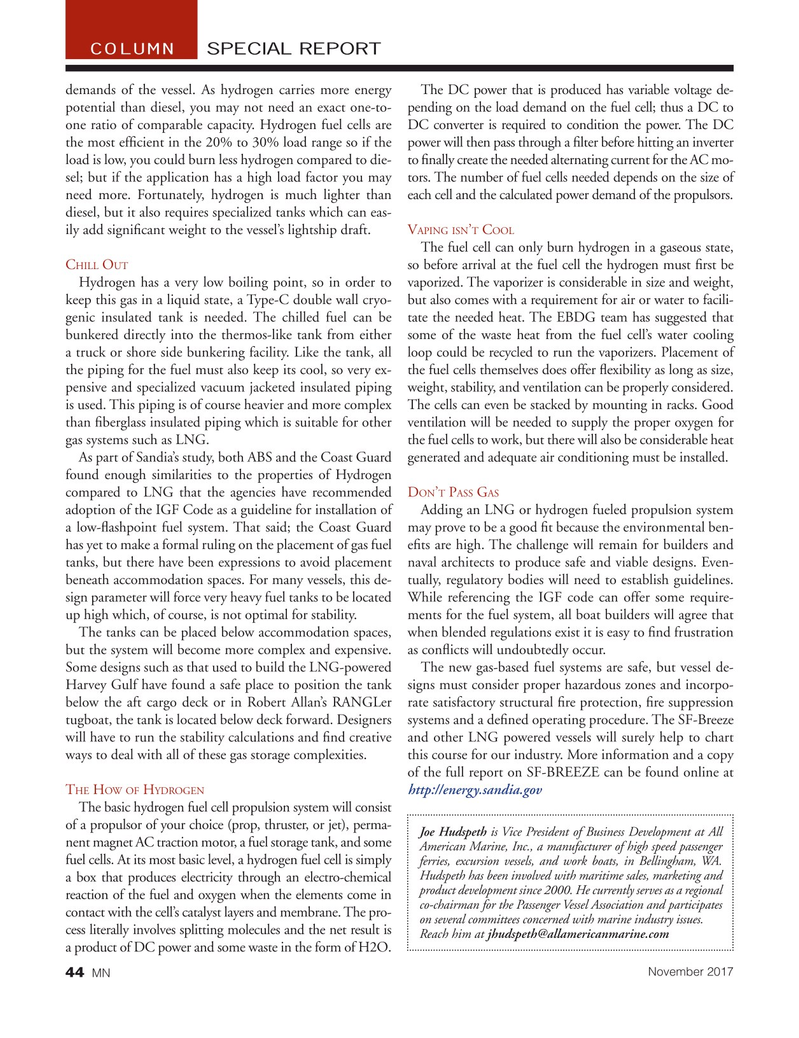
Page 44: of Marine News Magazine (November 2017)
Workboat Annual
Read this page in Pdf, Flash or Html5 edition of November 2017 Marine News Magazine
COLUMN SPECIAL REPORT demands of the vessel. As hydrogen carries more energy The DC power that is produced has variable voltage de- potential than diesel, you may not need an exact one-to- pending on the load demand on the fuel cell; thus a DC to one ratio of comparable capacity. Hydrogen fuel cells are DC converter is required to condition the power. The DC the most ef? cient in the 20% to 30% load range so if the power will then pass through a ? lter before hitting an inverter load is low, you could burn less hydrogen compared to die- to ? nally create the needed alternating current for the AC mo- sel; but if the application has a high load factor you may tors. The number of fuel cells needed depends on the size of need more. Fortunately, hydrogen is much lighter than each cell and the calculated power demand of the propulsors. diesel, but it also requires specialized tanks which can eas- ily add signi? cant weight to the vessel’s lightship draft. V ’ CAPING ISN T OOL
The fuel cell can only burn hydrogen in a gaseous state,
HILL UT
C O so before arrival at the fuel cell the hydrogen must ? rst be
Hydrogen has a very low boiling point, so in order to vaporized. The vaporizer is considerable in size and weight, keep this gas in a liquid state, a Type-C double wall cryo- but also comes with a requirement for air or water to facili- genic insulated tank is needed. The chilled fuel can be tate the needed heat. The EBDG team has suggested that bunkered directly into the thermos-like tank from either some of the waste heat from the fuel cell’s water cooling a truck or shore side bunkering facility. Like the tank, all loop could be recycled to run the vaporizers. Placement of the piping for the fuel must also keep its cool, so very ex- the fuel cells themselves does offer ? exibility as long as size, pensive and specialized vacuum jacketed insulated piping weight, stability, and ventilation can be properly considered. is used. This piping is of course heavier and more complex The cells can even be stacked by mounting in racks. Good than ? berglass insulated piping which is suitable for other ventilation will be needed to supply the proper oxygen for gas systems such as LNG. the fuel cells to work, but there will also be considerable heat
As part of Sandia’s study, both ABS and the Coast Guard generated and adequate air conditioning must be installed.
found enough similarities to the properties of Hydrogen compared to LNG that the agencies have recommended D ’ P GON T ASS AS adoption of the IGF Code as a guideline for installation of Adding an LNG or hydrogen fueled propulsion system a low-? ashpoint fuel system. That said; the Coast Guard may prove to be a good ? t because the environmental ben- has yet to make a formal ruling on the placement of gas fuel e? ts are high. The challenge will remain for builders and tanks, but there have been expressions to avoid placement naval architects to produce safe and viable designs. Even- beneath accommodation spaces. For many vessels, this de- tually, regulatory bodies will need to establish guidelines. sign parameter will force very heavy fuel tanks to be located While referencing the IGF code can offer some require- up high which, of course, is not optimal for stability. ments for the fuel system, all boat builders will agree that
The tanks can be placed below accommodation spaces, when blended regulations exist it is easy to ? nd frustration but the system will become more complex and expensive. as con? icts will undoubtedly occur.
Some designs such as that used to build the LNG-powered The new gas-based fuel systems are safe, but vessel de-
Harvey Gulf have found a safe place to position the tank signs must consider proper hazardous zones and incorpo- below the aft cargo deck or in Robert Allan’s RANGLer rate satisfactory structural ? re protection, ? re suppression tugboat, the tank is located below deck forward. Designers systems and a de? ned operating procedure. The SF-Breeze will have to run the stability calculations and ? nd creative and other LNG powered vessels will surely help to chart ways to deal with all of these gas storage complexities. this course for our industry. More information and a copy of the full report on SF-BREEZE can be found online at
T H H http://energy.sandia.gov
HE OW OF YDROGEN
The basic hydrogen fuel cell propulsion system will consist of a propulsor of your choice (prop, thruster, or jet), perma-
Joe Hudspeth is Vice President of Business Development at All nent magnet AC traction motor, a fuel storage tank, and some
American Marine, Inc., a manufacturer of high speed passenger fuel cells. At its most basic level, a hydrogen fuel cell is simply ferries, excursion vessels, and work boats, in Bellingham, WA.
Hudspeth has been involved with maritime sales, marketing and a box that produces electricity through an electro-chemical product development since 2000. He currently serves as a regional reaction of the fuel and oxygen when the elements come in co-chairman for the Passenger Vessel Association and participates contact with the cell’s catalyst layers and membrane. The pro- on several committees concerned with marine industry issues. cess literally involves splitting molecules and the net result is
Reach him at [email protected] a product of DC power and some waste in the form of H2O.
November 2017 44
MN

 43
43

 45
45
